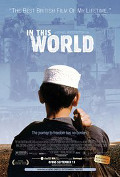
Directed by
Michael Winterbottom
100 minutes
Rated M
Reviewed by
Ruth Williams

In This World
Synopsis: Jamal and Enayatullah are cousins who live in the Pakastani city of Peshawar. Jamal’s parents are dead, so Jamal spends his days working in a brick factory. He returns at night to the Shamshatoo refugee camp where he looks after his younger siblings. His cousin works at his family’s stall in the market. When Enayatullah’s uncle decides to send him to London in search of a better life, Jamal convinces the family to send him as a travelling companion as he speaks English. The two cousins travel across country via whatever means they can, placing themselves at the mercy of people smugglers.With a solemn voice-over, on location shooting, distressing statistics and computer generated maps tracking the journey, it would be easy to assume that you are watching a documentary. That’s if you were willing to ignore the fact that many of the shots would have to have been set up in order to achieve certain angles and particular scenes.
Researching the film, the writer, Tony Grisoni, read hundreds of stories of people who had put themselves in the hands of the smugglers in order to escape poverty in their homelands. Director Winterbottom however was not so much interested in documenting an actual event but rather the essence of the lives of many, his intention being to open our eyes to the plight of those who merely want a better life for their children. He particularly hoped to show that just because a migrant wants to leave their country for economic reasons, doesn’t mean they are any less worthy than a political refugee.
In witnessing the immense journey the boys must make, we can’t help but open our hearts to their plight. And, as the film makes clear, it is not just their plight. There are one million refugees every year who are willing, or forced, to risk their lives this way.
With a small budget, digital video cameras, minimal crew and non-professional actors, Winterbottom and Grisoni worked from a thirty-page outline rather than a full script. This resulted in a total of 200 hours of footage that they managed to cut back to the eighty-eight minutes in the final cut. This is exciting filmmaking. Making the trip themselves, the filmmakers had first-hand experience of the kind of obstacles that so many refugees face each day. Just as Jamal and Enayatullah are stopped at a border road block, unable to speak the language and fearful for their lives, the filmmakers found themselves in a similar situation.
For all the praise Winterbottom and Grisoni deserve for going to such lengths to tell this story, the focus should be on the people who inspired such action. We know now, after events in our own backyard, the effect that putting names and faces and life stories to these “illegal immigrants” can have on those born into taken-for-granted opportunity. As a result of this film, hopefully, at least in some small way, the pressure will increase for governments to open their hearts and their purses. To see the look on the face of Enayatullah’s uncle when he learns of the fate of his nephew is to witness a man whose heart has been torn one time too many.

Want more about this film?


Want something different?




